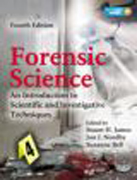
Forensic Science: An Introduction to Scientific and Investigative Techniques Fourth Edition, Book and Online
James, Stuart H.
Nordby, Jon J.
Bell, Suzanne
Presents contributions from some of the greatest experts in the field Uses case studies taken from the experts’ personal files along with stunning photographs Organizes chapters into topics most popular for coursework Includes coverage of all forms of evidence, from bloodstain pattern and DNA to questioned documents and structural collapses Contains sidebars with historical notes, practical information, current events, and advice for career advancement Provides real-life case studies, chapter summaries, key terms, review questions, and references for further reading Includes access to an identical eBook version Ancillaries for Instructors: 700 PowerPoint® lecture slides More than 700 questions and answers—more than half multiple choice 480 mages, including more than 130 not in the textbook itself Court testimony transcript for use in lectures Laboratory exercises Additional chapters from the Third Edition Two extra in-depth case studies on firearms and arson (photos included) Further readings on entomological evidence and animal scavenging (photos included) Summary Covering a range of fundamental topics essential to modern forensic investigation, the fourth edition of the landmark text Forensic Science: An Introduction to Scientific and Investigative Techniques presents contributions from experts in the field who discuss case studies from their own personal files. This edition has been thoroughly updated to reflect the cutting edge of forensic science across many different areas. Designed for a single-term course at the lower undergraduate level, the book begins by discussing the intersection of law and forensic science, how things become evidence, and how courts decide if an item or testimony should be admissible. It takes the evidence from crime scene investigation into laboratory analysis and even onto the autopsy table for the fullest breadth of subject matter of any forensic text available. Topics include Forensic anthropology and the role of entomology in a death investigation Death investigation, including identifying the cause, manner, mechanism, and time of death Bloodstain pattern analysis, the identification of blood and body fluids, the work of forensic toxicologists, and seized drug analysis The history and development of DNA typing and the many ways it can be used Fingerprint, firearm and ballistic, tool mark, tread impression, and trace evidence The forensic analysis of questioned documents and computers Arson, fire, explosives, and the work of forensic engineers in vehicular accidents and structural collapses Forensic psychology and psychiatry, including criminal profiling The future of forensic science Going beyond theory to application, this text incorporates the wisdom of forensic practitioners who discuss the real cases they have investigated. Color-coded sidebars in each chapter provide historical notes, case studies, and current events as well as advice for career advancement. Each section and each chapter begins with an overview and ends with a summary, and key terms, review questions, and up-to-date references are provided. Appropriate for any sensibility, more than 300 photos from real cases give students a true-to-life learning experience. *Access to identical eBook version included
- ISBN: 9781439853832
- Editorial: CRC PRESS LLC
- Encuadernacion: Tela
- Páginas: 614
- Fecha Publicación: 10/01/2014
- Nº Volúmenes: 1
- Idioma:
